Fens
What is a fen?
Fens are low to moderate fertility wetlands that are fed by both groundwater and surface runoff. They usually occupy gently sloping ground such as the toes of hillsides. The main feature is that the water able is close to the surface so they are very wet with slow to moderate water movement. The water table does not fluctuate much throughout the year. Being on slightly sloping ground, fens are more fertile than bogs though they can share some of the same features. They often grade into more fertile swamps. Generally there is a build-up of peat from the breakdown of dead plant matter. Fens are rare in Northland and are sometimes confused with swamps.
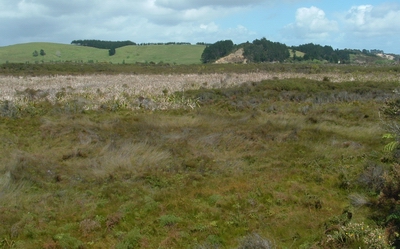
Why are fens so important?
Fens are one of the rarest wetland classes in Northland and contain a very high diversity of plant and animal life because they share some of the features of low fertility bogs as well as higher fertility swamps. Black mudfish are rare and fens are one of a few homes for them. Other animals such as fernbirds, bitterns and green gecko are also found in these areas. Fens are wet all year round storing water and releasing it slowly during dry periods. They also act as filters for streams and rivers lower down, improving water quality by capturing runoff and scrubbing out nutrients and sediments.
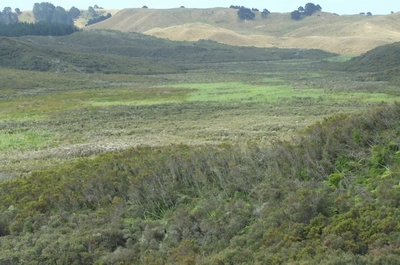 Maitahi Scientific Reserve, north of Dargaville.
Maitahi Scientific Reserve, north of Dargaville.
Vegetation
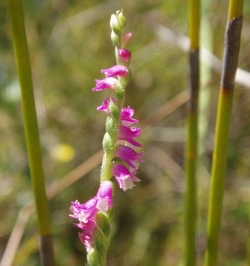 Fen vegetation in Northland is often made up of sedges including Baumea and Schoenus, ferns, flax and also manuka. In less fertile areas there may be bog vegetation (see Bogs fact sheet) and further down or around areas of flowing water there may be vegetation such as cabbage trees (ti kouka) and raupō which characterise fertile swamps (see Swamps fact sheet).
Fen vegetation in Northland is often made up of sedges including Baumea and Schoenus, ferns, flax and also manuka. In less fertile areas there may be bog vegetation (see Bogs fact sheet) and further down or around areas of flowing water there may be vegetation such as cabbage trees (ti kouka) and raupō which characterise fertile swamps (see Swamps fact sheet).
This can lead to a very high plant diversity especially around the zones where there is a boundary between habitats (ecotones).
Animals
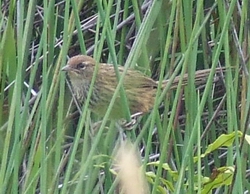 Some of Northland's fens have high populations of rare black mudfish. During summer these fish are able to survive for up to two months in damp peat only needing shelter from vegetation to keep them moist.
Some of Northland's fens have high populations of rare black mudfish. During summer these fish are able to survive for up to two months in damp peat only needing shelter from vegetation to keep them moist.
Fernbirds are also found in fens.
Other birds that might be visiting fens are bitterns and spotless crakes. Green geckos can sometimes be seen sunning themselves on the stems of plants on warm days.
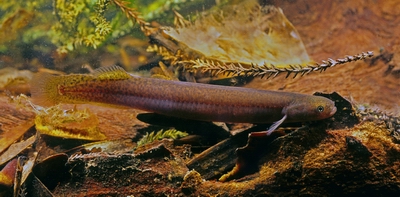 Black mudfish (Copyright: Rod Morris).
Black mudfish (Copyright: Rod Morris).
Looking after your fen
You may be eligible for a Northland Regional Council Environment Fund grant for up to 50 percent of the costs of wetland fencing, pest control and planting.
Hydrology (water levels)
Fens have flowing water all year round and the water table, which is close to the surface, does not fluctuate greatly. It is important that water levels in fens are kept stable and retained. Drainage of surrounding land may be degrading your fen by lowering the water levels causing areas to dry out and become weedy. Peat forms in fens because low oxygen levels in the saturated soil causes dead plant material to decompose slowly. When fens are drained, oxygen penetrates the peat (oxidises) causing it to shrink and the land surface to lower. Unfortunately once this happens it is extremely difficult to restore the peat as it can take thousands of years to rebuild. The way to look after peat soils, both on farms and in wetlands is to make sure the water levels are maintained so the peat stays damp. It may mean putting in a weir downstream to retain water levels, filling in a drain or not maintaining a drain.
Remember that before you make any changes to the water levels in a wetland you need to contact the Northland Regional Council, as you may need a resource consent.
Nutrients
Because fens are low to moderate (intermediate) fertility they re vulnerable to nutrient inputs. Increases in fertility will cause vegetation changes. Fertility loving native plants - such as raupō and cabbage trees - generally favour fens because they are so wet. However, to retain the intermediate fertility characteristics of these rare ecosystems, it is important to keep inputs of nutrients as close to natural levels as possible.
Prevent increases in fertility in fens by:
- Managing the basin or any catchment area that feeds the fen;
- Preventing fertiliser drift and runoff;
- Fence out stock with a marginal buffer to prevent effluent and pasture runoff reaching the fen.
Remember that before you make any changes to the water levels in a wetland you need to contact the Northland Regional Council, as you may need a resource consent.
Stock
Stock, especially heavy animals, do a great deal of damage to wet fens and they are not a good source of feed. Pugging breaks through peat, damages raupō crowns and stock browse softer plants. Animal effluent can also lead to increases in fertility on the margins. Stock also spread weeds or open up areas for weeds to move into. Stock don't generally push far into larger fens but smaller ones should be fenced.
Contact the Northland Regional Council for advice on fencing and how to apply for funding.
Plant pests
Maintaining water levels and avoiding drainage especially downstream will help stop invaders like gorse, pampas and Mexican devil. Some herbicides are not allowed to be used over water or in wetlands so please contact the Northland Regional Council for advice before you start weed control.
You can keep the weeds out by:
- Avoiding drainage or disturbance that will favour weed invasion;
- Fencing stock out to reduce disturbance and prevent weed spread;
- Washing and drying equipment and farm machinery after working in weedy areas or off your land;
- Eradicating weeds, especially any that can spread from higher up the catchment.
Animal pests
When it comes to animal pests, there are some basic rules of thumb:
- Black mudfish and frogs can't cope with gambusia (mosquito fish) so make sure you don't introduce them.
- Wetland birds, lizards and invertebrates respond well to basic pest control.
- Pest mammals include rabbits, possums, stoats, weasels, ferrets, hedgehogs, rats and cats.
- Wandering dogs harass or kill native birds.
Basic predator control is as easy as a line of traps or bait stations along tracks or around the edge of the wetland.
Contact a Northland Regional Council Pest Officer for advice on the best pest control methods for your situation and to apply for funding.
Ponds or dams
Digging ponds or damming outlets to create open water is usually not beneficial for fen wetlands.
Please contact the Northland Regional Council for advice and before considering creating a dam or pond as you may need a resource consent.
